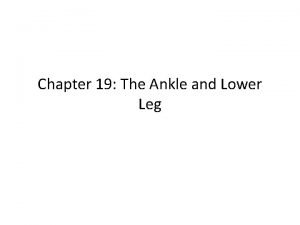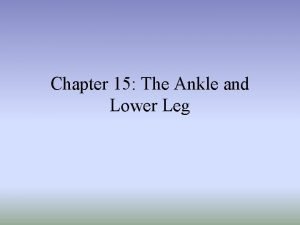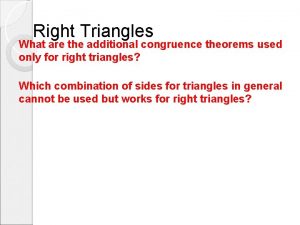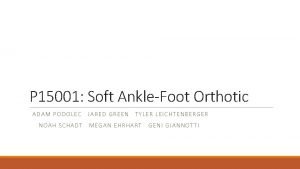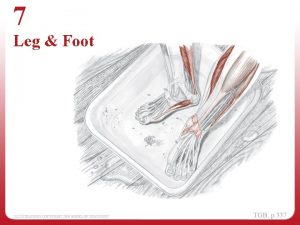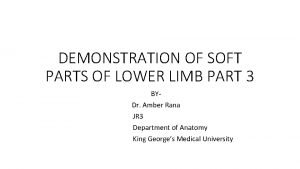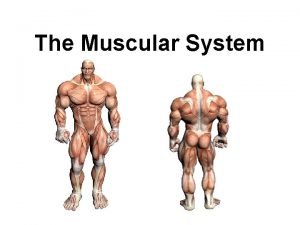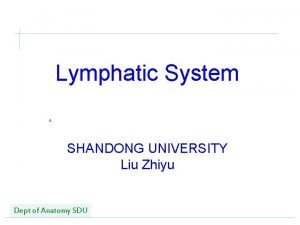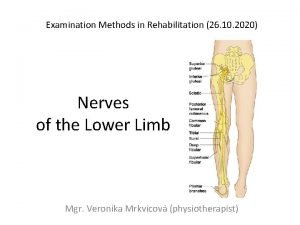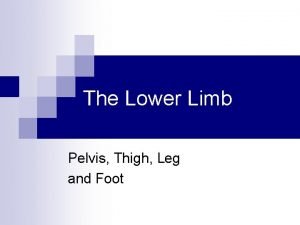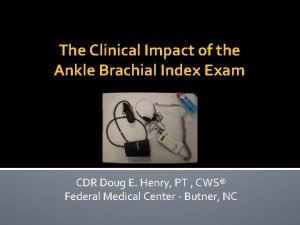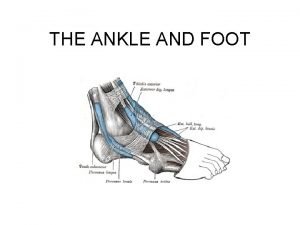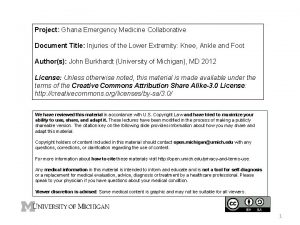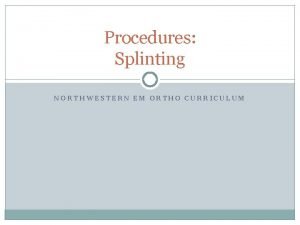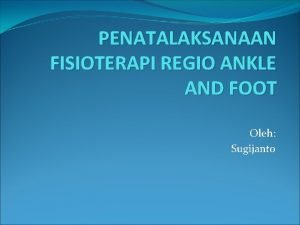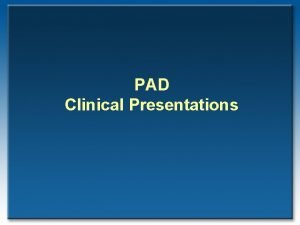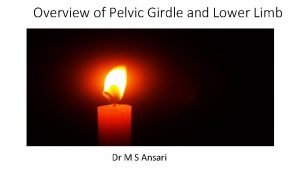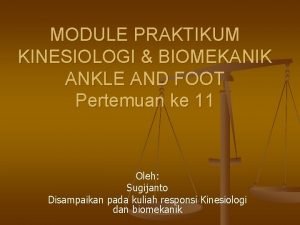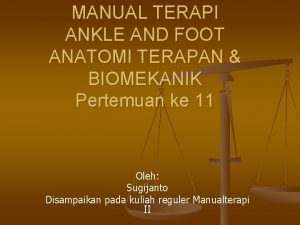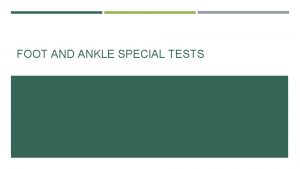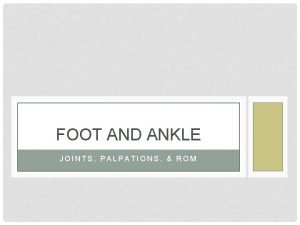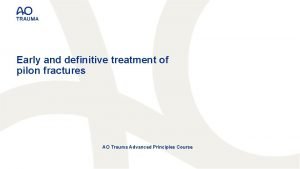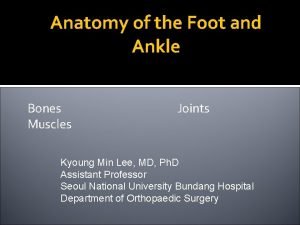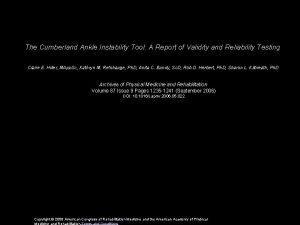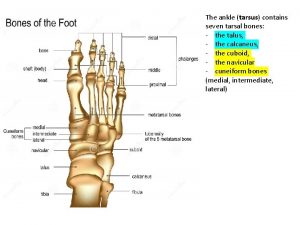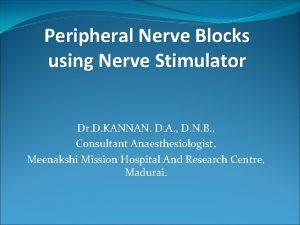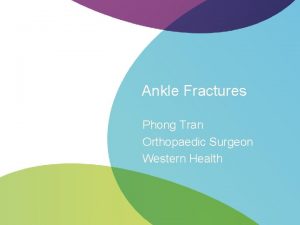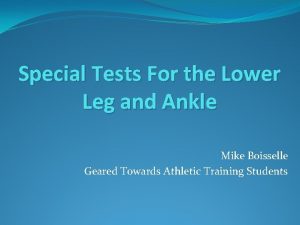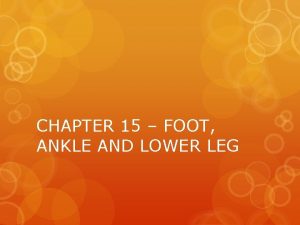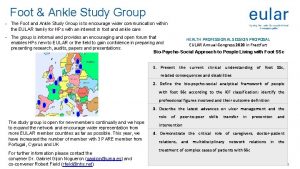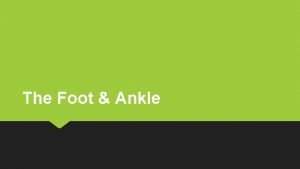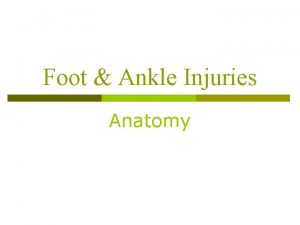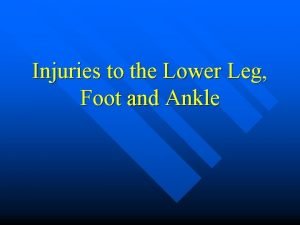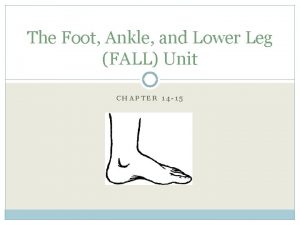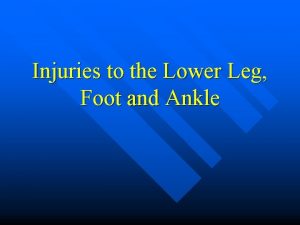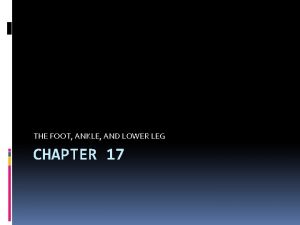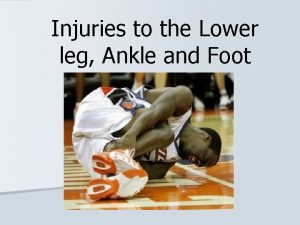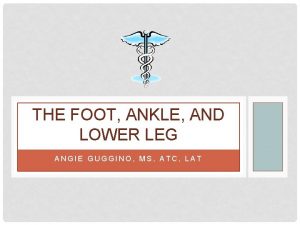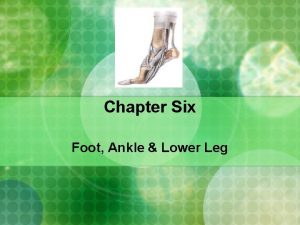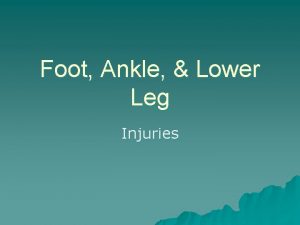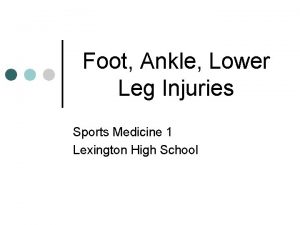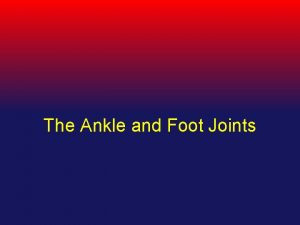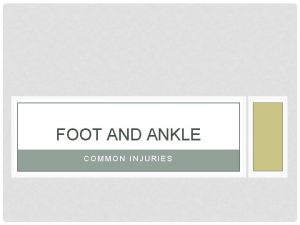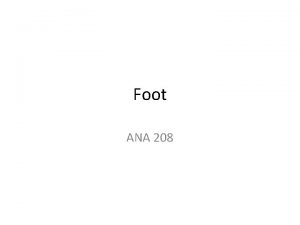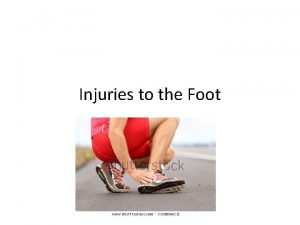Conditions of the Foot Ankle and Lower Leg







































- Slides: 39

Conditions of the Foot, Ankle, and Lower Leg (FALL)

Acute Anterior Compartment Syndrome � � � MOI: Direct blow to the anterior shin Etiology: A direct blow causes bleeding into the narrow space housing the nerves and blood vessels. The tight surrounding fascia allows very limited expansion. Pressure increases on the tibial artery and the deep peroneal nerve which cuts off blood flow and feeling. Medical Emergency: Intramuscular pressure and neurovascular compromise leads to ischemia (lack of oxygen) and necrosis (tissue pain) Signs and Symptoms: Severe throbbing pain, decreased strength with dorsiflexion and great toe extension, decreased sensation on the dorsum (top) of the foot, decreased circulation at the dorsal pedis pulse, glossy red tight skin Treatment: Emergency Fasciotomy

Acute Anterior Compartment Syndrome

Chronic Anterior Compartment Syndrome � � � MOI: Develops gradually with athletic activity Etiology: Gradual increase in pressure in the anterior compartment due to swelling and muscle hypertrophy Signs and Symptoms: Weak dorsiflexion and great toe extension, anterior shin pain, decreased sensation on the dorsum of the foot, decreased circulation. Evaluation: Have athlete exercise to the point when symptoms occur. Once symptoms occur, test strength, sensation, and circulation before symptoms decrease Treatment: Ice and evaluation, BUT NO COMPRESSION, monitor neurological status and girth measurements of the affected area, crutches for loss of sensation, and referral

Chronic Anterior Compartment Syndrome

Fracture(s) of the Tibia/Fibula � � � MOI: Direct blow to the lower leg or a rotational force from planting or turning on a fixed foot Etiology: Direct blow or rotational force that results in a transverse or spiral oblique fracture of the tibia/fibula Signs and Symptoms: Obvious deformity, swelling, ecchymosis (discoloration), crepitus(noise), and inability to bear weight especially when the tibia is involved Treatment: Immobilization, PRICES, refer to physician Special Test: Percussion /Bump Test And Compression/Squeeze Test

Fractures to the Tibia/Fibula

Special Tests for Stability of the Tibia and Fibula Percussion or Bump Testhelps determine a fracture Compression or Squeeze Test-helps determine a fracture or anterior/posterior tibiofibular sprain

Stress Fracture(s) of the Tibia/Fibula � � MOI: Overuse/Repetitive mechanical stress Etiology: The bone cannot adapt to repetitive loading and attempts to adapt with increasing the breakdown of bone. In return, the laying of new bone follow. Once the breakdown of bone exceeds the laying down of new bone, the bone begins to weaken and a stress fracture forms Signs and Symptoms: Pain during weight bearing activity and eventually non-weight bearing activity, localized swelling and point tenderness over the affected area Treatment: Refer for x-rays two weeks after injury; bone scan or MRI may be necessary; treat symptomatically for pain and return to activity when the asymptomatic (normally 4 -6 weeks); REST is the best treatment.

Stress Fractures of Tibia/Fibula

Shin Splints � � MOI: Overuse/Repetitive stress Etiology: Overuse/Repetitive stress forces acting on the proximal insertions of the Flexor Digitorum Longus, Tibialis Posterior, and /or Tibialis Anterior. Inflammation present along muscle attachments to tibia and insertions on the plantar surface Signs and Symptoms: Aching pain in shin that is aggravated with push-off phase and shock absorption during heel strike; athlete may excessively pronate(have flat feet) Treatment: Ice cup, taping or orthotics for foot mechanics, stretch routine, and rule out stress fracture. Active Rest!

Shin Splints

Achilles Tendon Rupture � � MOI: Strong force during resistive forceful plantarflexion of the ankle with the knee extended or forceful dorsiflexion of the ankle with contraction of the Gastrocnemius/Soleus Etiology: Partial/complete rupture of the Achilles tendon Signs and Symptoms: Athlete report a sensation of being kicked or shot in the calf, audible snap, and painful loss of function. Observable gap with a window shade affect, palpable gap, bunching of the tendon proximally, and massive swelling Special Tests: Thompson Test

Achilles Tendon Rupture

Grades of Achilles Tendon Strain

Thompson Test-for Achilles’ Tendon Ruptures

Achilles Tendonitis � � � MOI: Overuse injury Etiology: Microtrauma/Inflammation and possible thickening of the Achilles tendon Predisposing Factors: Tight achilles Tendon, Extremely High Arches, Excessively Flat Feet Signs and Symptoms: Pain proximal to calcaneal insertion, morning pain/stiffness, clicking sensation when walking, palpable crepitus, and swelling and thickening of the tendon. Functional Tests: loss of full dorsiflexion, painful and active and resistive plantarflexion Treatment: Ice cup and Ultrasound, heel lifts(both shoes), stretching, strengthening, and taping

Achilles Tendonitis

MOI for Ankle Sprains

Lateral Ankle Sprains � � � MOI: Inversion (inversion/plantarflexion) Etiology: Partial/complete rupture of the Anterior Talofibular Ligament, Calcaneofibular Ligament, and/or Posterior Talofibular Ligament, avulsion fracture of the malleolus, chip fracture of the medial malleolus Signs and Symptoms: Pain/Point tenderness over lateral ligamentous structures, as well as, the medial and lateral malleoli. Inability to bear weight without limp, swelling laterally and posteriorly with swelling migrating to the toes and possible crepitus. Special Tests: +Anterior Drawer, +Talar Tilt Treatment: PRICES, Crutches, Rehabilitation

Lateral Ankle Sprain

Special Tests for Lateral Ankle Sprains Talar Tilt Test-tests for the Calcaneofibular ligament Anterior Drawer (Ankle)-tests for the Anterior Talofibular ligament

Medial Ankle Sprains � � MOI: Eversion (Eversion/Dorsiflexion) Etiology: Partial/Complete rupture of the deltoid ligament, avulsion fracture of the medial malleolus, chip fracture of the lateral malleolus, spiral oblique fracture of the shaft of the tibia/fibula Signs and Symptoms: Pain/Point tenderness over medial ligamentous structures, as well as, the medial and lateral malleoli. Inability to bear weight without limp, swelling medially and posteriorly with additional swelling migrating to the toes and possibly crepitus. Special Tests: + Kleiger Test

Medial Ankle Sprains

Kleiger Test-determines a Medial Ankle Sprain and injury to the DELTOID ligament

Classification of Ankle Sprains � 1 st DEGREE: Mild stretching of the ligament with mild swelling, minor point tenderness, and no instability. � 2 nd DEGREE: Partial tear of the ligament with moderate swelling, pain, moderate point tenderness, ecchymosis, and instability with firm end field. � 3 rd DEGREE: Complete rupture of the ligament with severe swelling, ecchymosis, pain, and gross instability with a soft end field.

Heel Contusion (Heel Bruise) � � MOI: Direct blow to the heel during extreme weight bearing Etiology: Contusion to the heel area with irritation of the fat pad, calcaneus, and surrounding nerves Signs and Symptoms: Pain during weight bearing especially on the lateral side during heel strike, swelling in the heel area, ecchymosis, and palpable mass of blood. Treatment: Ice, padding, taping, crutches

Heel Bruise (Heel Contusion)

Retro-calcaneal bursitis (Pump Bump) � MOI: Overuse injury, caused by friction and pressure � Signs and Symptoms: Redness, swelling, warmth, callus formation, and point tenderness at the inserting of the Achilles Tendon � Treatment: Padding

Plantar Fasciaitis � � MOI: Overuse Etiology: The plantar fascia becomes inflames due to repetitive forces. Tightness of the plantar fascia is a common cause. Having a tight gastrocnemius/soleus complex as well as hamstrings may contribute. Signs and Symptoms: Pain and point tenderness at mid plantar surface and migrating to the calcaneus. Pain in the morning and during the push off phase of gait. Athlete may walk on the lateral side of foot to decrease their pain. Treatment: Ice cup and Ultrasound, Anti-inflammatory drugs, orthotics tape, stretching.

Plantar Fasciaitis

Sprain of the Metatarsalphalangeal Joint of the Great Toe – “Turf-Toe” � � MOI: Forces hyperextension or hyperflexion of the Metatarsalphalangeal Joint of the Great Toe. It is often seen when athletes wear flexible shoes on a hard surface. Etiology: Sprain of the plantar or dorsal ligaments of the MP joint of the great toe. Signs and Symptoms: Pain during push-off phase of gait, pain and swelling at the MP Joint, pain with passive extension or flexion and side to side motions. Treatment: Ice, tape, rigid shoes

Metatarsophalangeal Joint Sprain “Turf Toe”

Toe Fractures � � � MOI: Direct blow Signs and Symptoms: Pain with gait, swelling, ecchymosis Treatment: Refer to physician for x-rays

Base of the 5 th Metatarsal Fractures Sometimes called a Jones Fracture � MOI: Forced inversion � Etiology: Fracture occurs between the peroneus brevis and peroneus tertius. May disrupt blood supply-risk of non-union. It is very hard to heal! � Signs and Symptoms: Swelling, ecchymosis, point tenderness at the base of the 5 th metatarsal � Treatment: Refer for x-rays �

5 th Metatarsal Fractures

Avulsion Fractures � � MOI: Inversion Etiology: The inversion mechanism causes the muscles (peroneus brevis and peroneus tertius) to pull off a piece of the bone at the base of the 5 th metatarsal bone Signs and Symptoms: Swelling, ecchymosis, point tenderness at the base of the 5 th. Treatment: Refer for x-rays.

Avulsion Fractures

Blisters � MOI: Friction � Etiology: As the layers of skin rub together, friction causes a seperation. The body responds with fluid formation in this seperation. � Signs and Symptoms: Pain, fluid formation, open wound is possible � Treatment: Padding, Lubrication, Prevent infection at all times
 Chapter 19 worksheet the ankle and lower leg
Chapter 19 worksheet the ankle and lower leg Chapter 15 worksheet the ankle and lower leg
Chapter 15 worksheet the ankle and lower leg Physiology of the foot and ankle
Physiology of the foot and ankle Hl geometry
Hl geometry Ankle foot orthoses
Ankle foot orthoses Ankle foot orthosis project
Ankle foot orthosis project Ankle muscles
Ankle muscles Vein anatomy leg
Vein anatomy leg Parts of the lower leg
Parts of the lower leg Branches of popliteal artery
Branches of popliteal artery Temporalis
Temporalis Extensors of lower limb
Extensors of lower limb Abdominal wall lymphatic drainage
Abdominal wall lymphatic drainage Plexopathy
Plexopathy Thigh leg foot
Thigh leg foot You put your left foot in
You put your left foot in Solving right triangles
Solving right triangles Abi ratio
Abi ratio Ankle sprain grades
Ankle sprain grades Muscle of plantar flexion
Muscle of plantar flexion Knee extension rom
Knee extension rom Ottawa rule
Ottawa rule Post mold splint
Post mold splint Antalgi
Antalgi Abi index normal
Abi index normal Popliteal vein
Popliteal vein End feel pada ankle
End feel pada ankle Mtp 1 anatomi
Mtp 1 anatomi Ankle special tests
Ankle special tests Ankle rom
Ankle rom Chaput fragment ankle
Chaput fragment ankle Ankle muscle anatomy
Ankle muscle anatomy The cumberland ankle instability tool
The cumberland ankle instability tool Seven ankle bones
Seven ankle bones Perpneal tendon
Perpneal tendon Hammock carry drawing
Hammock carry drawing Dorsum leg
Dorsum leg Sustentaculum tali
Sustentaculum tali Phong tran surgeon
Phong tran surgeon Homan sign
Homan sign
